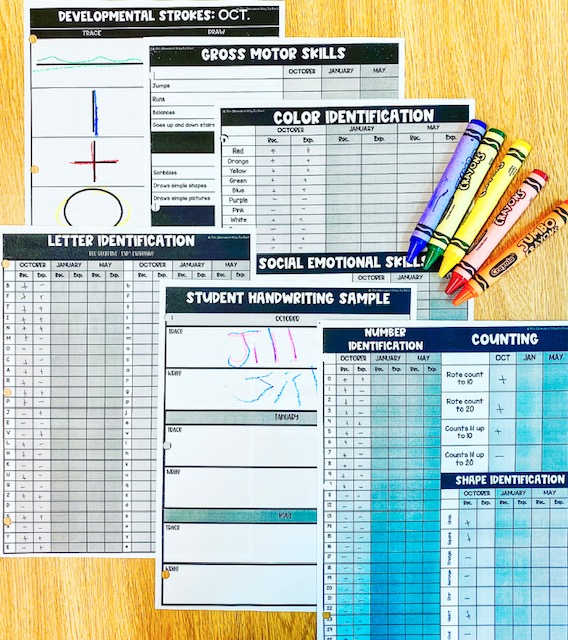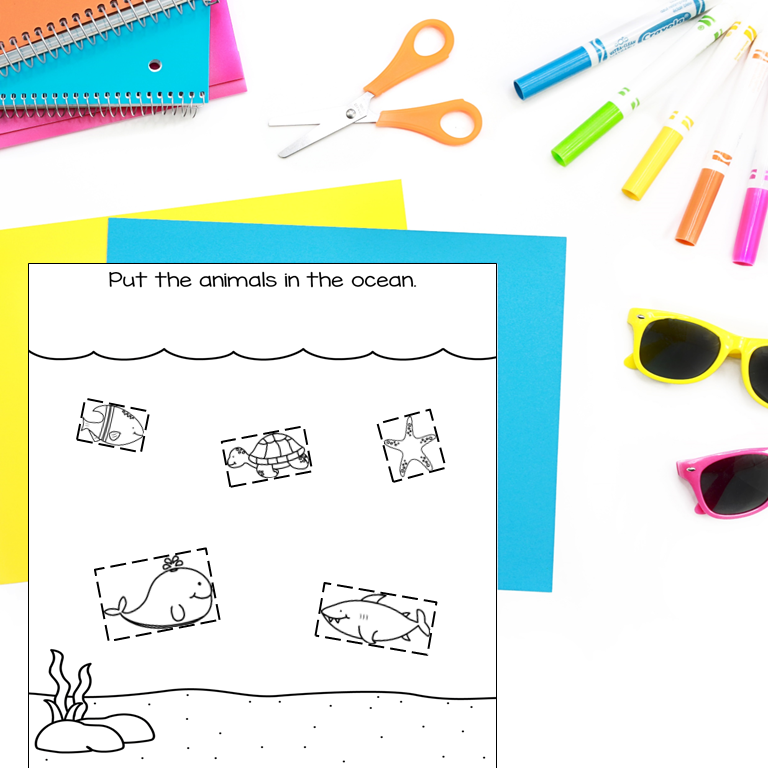Rotation Stations is a blended learning model that has been implemented in elementary classrooms developed by UDL (Universal Design for Learning). It is a great way to target IEP goals and work on school readiness skills like transition, working on a task, and simply remaining in the area.
Rotations Stations look a little different in every classroom. So let’s take a look at how I utilize Rotation Stations in my classroom. For a video walkthrough and to get a sense of things visually click HERE.
The Basics
In my classroom, there are a series of three rotations. Red table (craft with an assistant, blue table (1:1 and small group with teacher), and the carpet (student or SLP lead).
Depending on class size, I may add a green table, which is student-led (sensory toys and an educational iPad app.
All rotations happen in a 30-minute period with ten-minute rotations (40 minutes with green table).
Students are assigned small groups of 1-3 students at the beginning of the year. The transitions follow the same pattern.
When the timer goes off, students go to their next station. Rotation stations take place after circle time Monday – Thursday. On Friday we do a whole group baking lesson.

Teacher Station: Blue Tablele
This is my favorite because it is guaranteed 1:1 time! I work with students individually on their IEP goals and collect data or perform assessments. I have an array of materials that are implemented daily in this station. Materials used are differentiated per student and their needs/goals and correspond with what study we are doing or the book we are reading that week. I have a ton of different levels of materials and ones easy to differentiate for each student.
I like having a variety to keep kids engaged but also easy to swap out if it just isn’t a hit with the student that day. Some of our focuses are errorless tasks, file folders, unit cognition, unit tracing, letter and number weekly focus, social stories, and All About Me Books.
Within the ten min time frame, each student is allotted five mins 1;1 with me. The student I am not working with is independently playing with an open-ended toy that corresponds to our unit of study. You can find some of my favorites HERE. I usually use a simple table divider so that each student is able to focus on their work. If I have three students in my group I will group two students of similar skill sets together.
Assistant Station
Our amazing assistant runs our craft station. Students create works of art while learning. Crafts always correlate with our thematic unit. Students construct mini-masterpieces that showcase their always-improving skills.
Our craft always ties into IEP goals such as requesting, AAC usage, turn-taking, fine motor, social skills, and pre-academic skills. This table follows the same structure as the blue table, where five minutes of work for each student while the other works with an open-ended toy.
This is an important reminder to keep work authentic! We always present a completed version of the craft and model the steps for the student, but if the student wants to color outside the lines or put the eyes on the feet instead of the face, that is okay! Let them! Parents/families know when their child did not make it and that the teacher did it, too. Let their work be authentic.
If you are looking for some free craftivities (especially ones that align with Creative Curriculum) I have a TON in my free resource library.

Carpet Station: Student Lead
The student lead station is on the carpet with an open toy shelf. During this time students independently play with their group members. There are five slots on our toy shelf that are open during this time. This allows students to work on social skills and appropriate play.
All toys/materials are related to our thematic unit and IEP goals. Typically I will place my students that need to move a bit here first since rotations happen after the circle where they are in a more structured “sitting” setting.
If you have a second paraprofessional in your classroom during this time, I would place them here. Have them play with students in parallel and help monitor for safety. If you do not have a second person during this time, it can seem daunting.
Many students do not like to remain in the area independently. Create barriers with furniture to emphasize their boundaries during that time. You may need to get up and redirect students back to the area. However, if you have one student who just does not remain on the carpet and wants to wander, that is fine as long as they can do so safely.
Speech
I like to schedule my SLP to be in my room during this time. This way, she can be a station. Depending on your SLP, they may choose just to parallel play with centers. Or, my favorite, they do a speech station! The toy shelf is closed during that time, and students work with the SLP on a mini-lesson.
Student Lead Table: Green Table
This station is usually at a small table. I provide a bin full of sensory toys and an iPad with an educational app. Do I love putting my students on iPads? No, I hate it. But sometimes, you just have to do it. Some of my favorite apps are Starfall and Khan Academy. I put the device in guided access so they can not leave the app.
Transitioning Through Stations
This is usually where I get the most questions. “How do you get your kids to transition independently? My students won’t move!”
First, set a visual timer. When the timer goes off, you rotate.
Nine out of ten of your students are not going to do this independently. We usually have to guide each group to the next area. Usually, we rotate with the students. So my TA will walk her group over to the blue table, I will walk my students to the carpet, and on the way back to my table, I will walk the carpet students to the red table.
It is not always pretty because, as you know, many students do not like to stop a preferred activity. We use lots of visuals, countdown reminders, and lots and lots of grace. Some students pick up on this system quickly and will transition independently, but others require adult support. Just meet your students where they are.
Rotation Station Expectations
Rotation station has a lot of moving parts, literally. It’s not going to run perfectly with everyone sitting down and remaining where they need to be. It’s just not, and you need to accept that.
Once you make that mind shift, you can really focus on targeting the skills you need. Preschool is to prepare students for school-age programming. We are introducing the concept of working at a table, working independently, transitioning in the classroom, working on tasks, and remaining in the area.
We use rotation stations to build students’ tolerance to the high demands put on them in future grades. I do not expect all my students to sit down. I do not expect them all to attend to the task for the duration of the ten minutes. That just is not realistic. However, I do think it is important we implement rotation stations because has a wealth of learning opportunities to target tons of skills!
